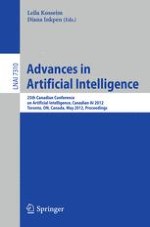2012 | Buch
Advances in Artificial Intelligence
25th Canadian Conference on Artificial Intelligence, Canadian AI 2012, Toronto, ON, Canada, May 28-30, 2012. Proceedings
herausgegeben von: Leila Kosseim, Diana Inkpen
Verlag: Springer Berlin Heidelberg
Buchreihe : Lecture Notes in Computer Science
